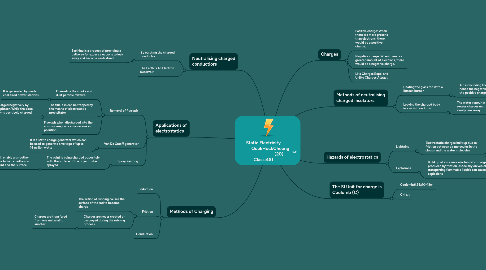
1. Methods of Charging
1.1. Induction
1.2. Friction
1.2.1. The action of rubbing causes the surface of the rod to become charge
1.2.2. Charges are never created or destroyed during the rubbing process
1.2.2.1. Charges are transfered from one material to another
1.3. Conduction
2. Neutralising charged conductiors
2.1. By earthing the charged conductor
2.1.1. Earthing is a process of providing a pathway for excess electrons to leak away and become neutralised
2.2. The Earth Is An Electron Reservoir
3. Applications of electrostatics
3.1. Removal of flue-ash
3.1.1. Flue-ash is the smoke and dust particle mixture
3.1.1.1. It is generated by modern coal-fired power stations
3.1.2. The flue-ash can be trapped by the means of electrostatic precipitator
3.1.2.1. The flue-ash is charged negatively by wires in the precipitator. While the plate of the precipitator is positively charged
3.1.2.1.1. As a result, the flue-ash will be attracted to the plate, preventing it from entering the atmosphere
3.1.3. Flue-ash when discharged into the atmosphere, can cause serious air pollution
3.2. Van De Graaff generator
3.2.1. It is a static charge generator which can be used to generate a voltage of up to 14 million watts
3.3. Spray Painting
3.3.1. The paint is being charged oppositely with the surface of the object to be sprayed
3.3.1.1. As a result, it will enable a smoother coat of paint due to better adhesion between the paint and the surface
4. Charges
4.1. Positive charge: When there are more protons than electrons, there would be a positive charge.
4.2. Negative charge: When there is a greater amount of electrons, there would be a negative charge.
4.3. Like Charges Repel and Unlike Charges Attract
5. The SI Unit for charge is Coulomb (C)
5.1. Coulomb:6.24x10^18e-
5.2. C=I x t
6. Methods of neutralising charged insulators
6.1. Heating the glass rod with a Bunsen burner
6.1.1. Air surrounding the rod woul be ionised, hence the negative ions will neutralise the positive charges on the glass rod
6.2. Leaving the charged body in a moist condition
6.2.1. The water vapour in the air can cause excess charges on the insulator to slowly leak away
7. Hazards of electrostatics
7.1. Lightning
7.1.1. Electrostatic charges built up due to friction between air molecules in the clouds and the water molecules
7.1.1.1. When charges build up to become sufficiently large, it can be discharged by ionising the air around them which can then provide a path for the lightning
7.2. Explosions
7.2.1. Build up of excessive electrostatic charges produced by friction, especially on vehicles transporting flammable liquids can cause explosions
